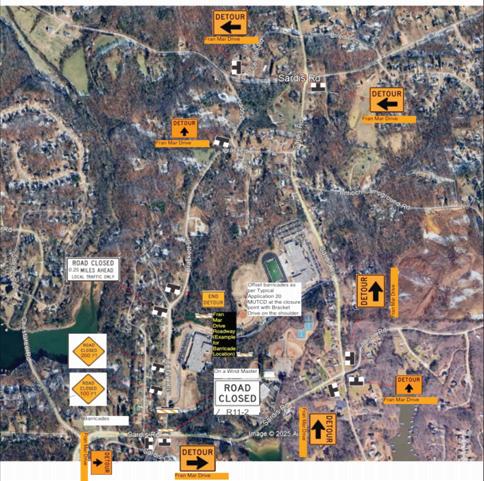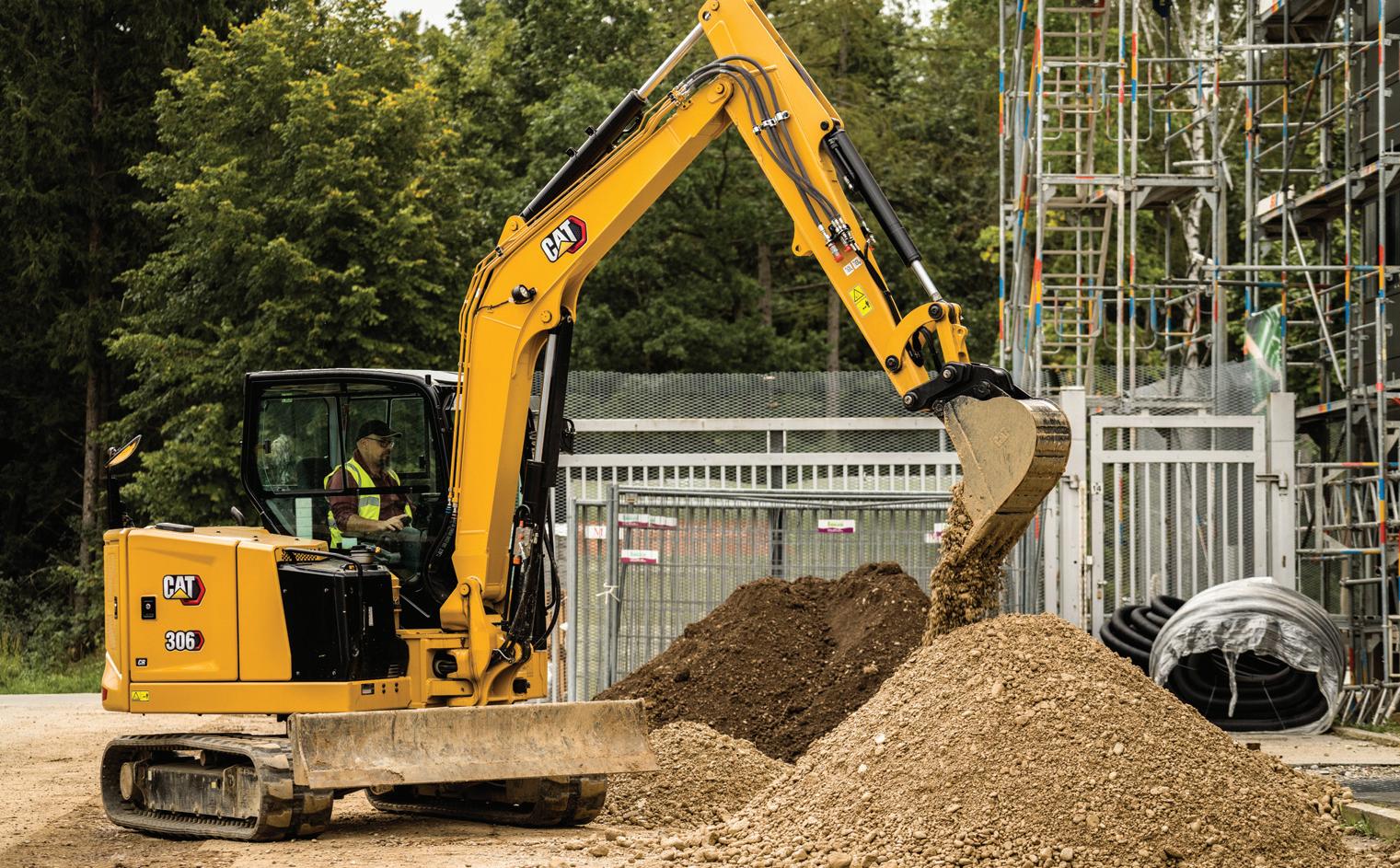






The Georgia Department of Transportation (GDOT) has started building the Sardis Road Connector, which the state agency calls “a transformative transportation project aimed at improving mobility in Hall County.”
The project was designed to enhance north-south connectivity in Gainesville between Georgia Highway 53 and Ga. 60 while easing congestion on nearby roadways, the department said July 15, 2025.
GDOT awarded the building contract for the Sardis Road Connector project, worth $57.2 million, to E.R. Snell Contractor LLC in Snellville, Ga.
Its crews kicked off the construction at the intersection of Sardis Road and Chestatee Road and will continue building north to Ga. 60 near Mt. Vernon Road, a distance of approximately 3.55 mi. The route follows a combination of
and
on




Just west of Atlanta, a city notorious for its often nightmarish traffic tie-ups, work began July 21 to upgrade what Georgia officials are calling one of the country’s worst freight transportation bottlenecks.
The Georgia Department of Transportation (GDOT) officially began a project to improve the Interstate 285/Interstate 20 West Interchange in Fulton and Cobb counties. More lanes will be built along I-20 that will also benefit travelers in Douglas County.
The agency has said that the $1.2 billion infrastructure project represents the second-biggest investment it has ever made.
Legacy Infrastructure Contractors is the partnership responsible for the design, construction and partial financing of the project. It is made up of Marietta, Ga.’s C.W. Matthews Contracting Co., as the primary builder and Infrastructure Consulting & Engineering LLC, headquartered in West Columbia, S.C., as the lead designer.
The team will reconstruct and widen several interstate sys-
tem-to-system ramps at the I-285/I-20 interchange and add a combination of collector-distributor/connecting lanes and auxiliary lanes along I-20 west and I-285 north of the junction.
GDOT explained that collector-distributor (CD) lanes run parallel to the main travel lanes of an interstate or highway, connecting them to access roads or entrance ramps in order to improve traffic flow, speed and safety.
The project’s I-20 footprint stretches from Factory Shoals Road, west of the interchange, to Hamilton E. Holmes Drive, on the east side.
Proposed improvements include:
• removal of left-hand ramp entrance and exit ramps from the I-285/I-20 interchange system;
• a new geometric design and vertical grades;
• building two-lane ramps within the interchange;
• installing westbound CD lanes from I-285/I-20 West to Georgia Highway 70/Fulton Industrial Boulevard;

















































































Your choice of a sealed or pressurized cab is equipped with system, adjustable wrist rests and a suspension seat to help comfortably all day long. Controls are easy to use, and the i monitor provides customizable machine operator preferenc information.
Maneuvering on the jobsite is even easier with the Cat Stick traditional travel controls with levers and pedal to joystick c button.
an improved air conditioning p keep you working ntuitive Next Generation es and easy to read machine
Increased lifting, swinging and travel and multi-functional pe k Steer option. Switch from controls with a push of a erformance help you get the
are just a few of the safety feature
Maintenance is quick and easy on access at ground level with group
with a variable displacement pum es built into the
the Cat 306 CR. Routine check poi ped service points and robust servic &
mp, the Cat 306 CR was designed to ints are easy to ce panels. reduce operating
blade, angle blade or Extra Tool C
Contact our dealership today t excavator in the market. arrier (XTC). to learn more about the newest 6-t
INTERCHANGE from page 1
• adding approximately 6 mi. of new lanes along I-20 from Factory Shoals Road to Hamilton E. Holmes Drive;
• constructing roughly 2 mi. of additional lanes along I285 from Donald Lee Hollowell Parkway south to MLK Jr. Drive to accommodate the interchange upgrades; and
• modifying and/or replacing bridge structures and ramps within the interchange and along I-20, including those over the Fulton County Railway and the Chattahoochee River.
According to GDOT, the interchange ramps will be modified to shift exits from the left to the right lane, cutting down vehicle weaving. Those ramps also will be widened.
The project is a part of the Major Mobility Investment Program (MMIP), the largest investment in roadway mobility improvements in the Georgia’s history.
According to the American Transportation Research Institute (ATRI), the I-285/I-20 interchange is ranked as the sixth most congested in the nation, and the 10th worst freight bottleneck in the U.S.
While site preparation activities were ongoing, GDOT and its construction partners mobilized heavy equipment and positioned two cranes within the loop ramp from I-20 eastbound to I-285 northbound to support the upcoming work on key structures.
With the construction now under way, drivers moving through the corridors can expect nightly lane closures and traffic pacing, which will likely cause delays.
Traffic pacing may happen in the late mornings, Monday
through Thursday through the end of the summer on I-285 southbound starting at Bolton Road.
According to GDOT, each operation may last up to 20 minutes, and it advises motorist to expect small delays during that time and consider using navigation apps for alternate routes.
There also will be a controlled blasting within the interior
the management of C.W. Matthews also have delineated construction entrances and exits from the interstate with a specific type of rock, known as “34 stone.” These strategically placed stones play a crucial role in making sure that heavy construction equipment does not get stuck in the mud while maintaining road cleanliness.
As these vehicles exit the site, the texture of the 34 stone helps to dislodge and remove excess mud and dirt from their tires, preventing the debris from being tracked onto the highway and providing safer driving conditions for all motorists, GDOT noted online.
“We’re excited to officially begin heavy construction on the I-285/I-20 West Interchange project.”
Donald Stull Georgia Department of Transportation
of the interchange along the I-285 southbound and I-20 eastbound ramp. Law enforcement will be on-site to manage traffic, and nearby residents may hear increased noise levels due to blasting.
The state transportation agency reported that crews under
The first major structure scheduled to be built will be the flyover ramp from I-20 westbound to I-285 southbound.
In preparation for this structure, workers will build temporary and permanent tie-back retaining walls, a common type of wall system used in major highway construction projects to support deep excavations and stabilize slopes.
On the I-285/I-20 West Interchange project, tie-back walls are particularly instrumental because of the project’s urban environment and tight corridors where space constraints and nearby infrastructure make traditional slope grading or gravity walls impractical.
“We’re excited to officially begin heavy construction on the I-285/I-20 West Interchange project,” said Donald Stull, GDOT’s project manager at the highway work site. “We appreciate the public’s patience as we get started constructing a more modern interchange with improved safety for the traveling public top of mind. While construction can be a temporary inconvenience, the long-term impacts will greatly enhance local and regional travel.”
MILITARY from page 1
The future Sardis Road Connector will be a four-lane, curb-and-gutter divided roadway with two travel lanes in each direction, separated by a 20-ft.-wide raised median. Sidewalks also will be constructed on both sides of the street, promoting safer pedestrian access and walkability.
“As Hall County continues to grow, so does the demand for safer, more efficient routes. The Sardis Road Connector is a critical piece of that solution,” said Grant Waldrop, a GDOT district engineer. “It provides a more direct route between two major state routes and relieves pressure on surrounding local roads.”
During construction, Sardis Road will serve as the area’s designated street detour, helping to keep traffic moving safely through the area while work is ongoing, GDOT noted.
Democratic U.S. Sen. Jon Ossoff announced July 18, 2025, that he has helped secure the largest military construction and quality-of-life investment for the state since 2010, delivering a major funding package through the Senate Appropriations Committee.
The legislation now heads to the full Senate for a vote and must also pass the U.S. House of Representatives.
As the top Democrat on the Appropriations Subcommittee on Military Construction, Ossoff led efforts to include $556 million for nearly a dozen projects across Georgia in the newly passed bipartisan appropriations bill.
The Senate bill also includes $30 million — $10 million each for the Army, Navy and Air Force — to strengthen oversight and maintenance of privatized military housing, including investigations into housing conditions.
Among the largest single allocations is $127.4 million for a new Dexter Elementary School at Fort Benning, near Columbus. Ossoff characterized the investment in the Army post as a top priority.
WAGA-TV in Atlanta noted that other major projects in the bill include:
• $166 million for an evidence storage building at Fort Gillem, southeast of Atlanta;
• $119 million for a Trident Refit Facility expansion at St. Mary’s, Ga.;
• $45 million for new Army barracks at Fort Stewart, southwest of Savannah; and
• $28 million for a new control tower at
Robins Air Force Base in the city of Warner Robins.
Ossoff said the new tower at Robins AFB is essential to support incoming missions and modern air traffic control infrastructure.
“Robins needs world-class infrastructure,” he said. “It’s time for [the base] to have a new state-of-the-art control tower.”
Also in the appropriations bill are:
• $17.5 million for a security forces operations facility and $3.7 million for F-35A simulator design at Moody Air Force Base, near Valdosta;
• $27 million for a dining and training facility and $11.4 million for a corrosion control facility at Savannah/Hilton Head International Airport; and
• $3 million for the design of a main gate at Dobbins Air Reserve Base, northeast of Atlanta.
“In my position as the ranking member leading the military construction subcommittee, the draft bill that we have now passed through the Senate Appropriations Committee — a major milestone — would deliver more military construction funding to the state of Georgia than any time in the last 15 years,” Ossoff said during a press briefing.
WAGA-TV reported that in reference to the plans for Fort Benning’s Dexter Elementary, Ossoff said, “The school that kids are in now is just not up to the standard. We are now making potentially historic progress toward getting it done.”
In response to a media question about Fort Gordon, the first-term U.S. senator noted that while this bill focuses on construction, $10 million was included for broader oversight of privatized military housing.
Ossoff added that ongoing issues with housing at Fort Gordon would be addressed through separate legislation, known as the National Defense Authorization Act, which is still being negotiated on Capitol Hill.
“My goal is to include in the defense authorization those provisions to support military families and strengthen oversight of those housing contractors,” he said.
Ossoff also emphasized the bipartisan support for the Senate bill, calling it “almost unanimous” despite a polarized political climate.
“We still have a ways to go, but I am doing everything in my power to bring Republicans and Democrats together to get this across the finish line,” he said.























